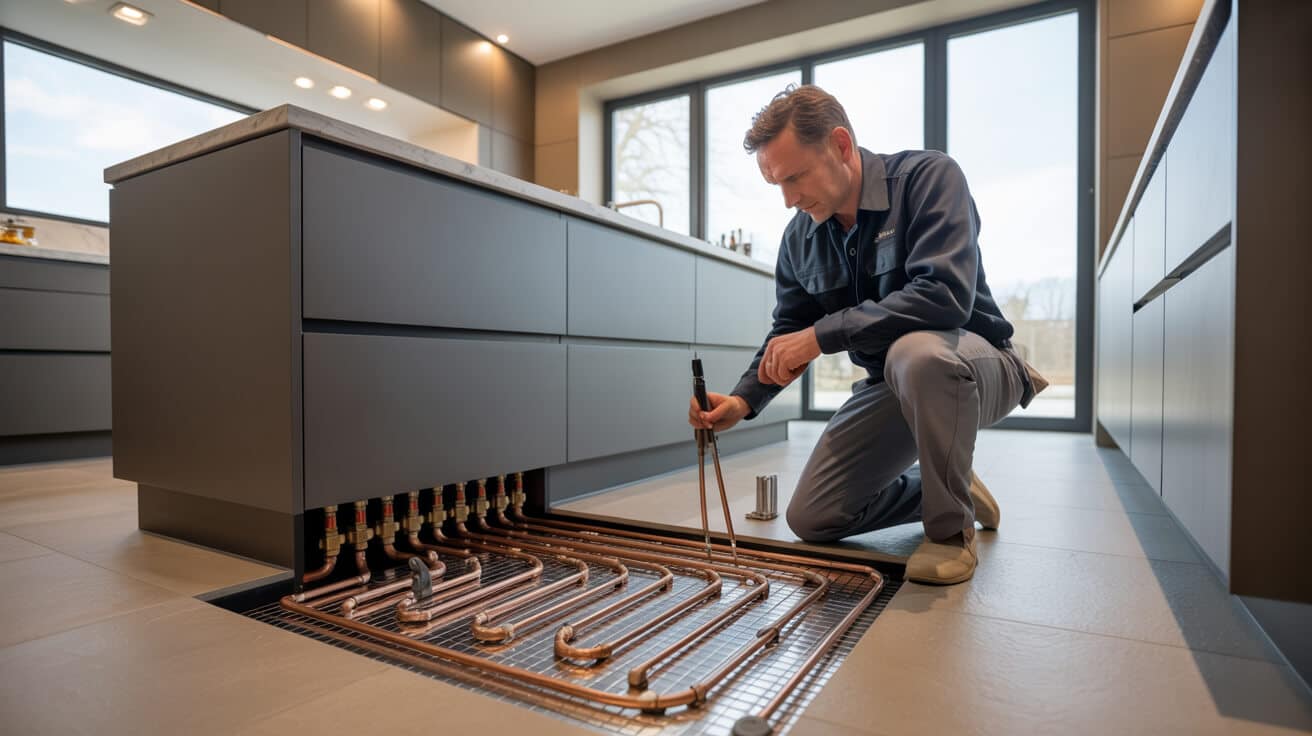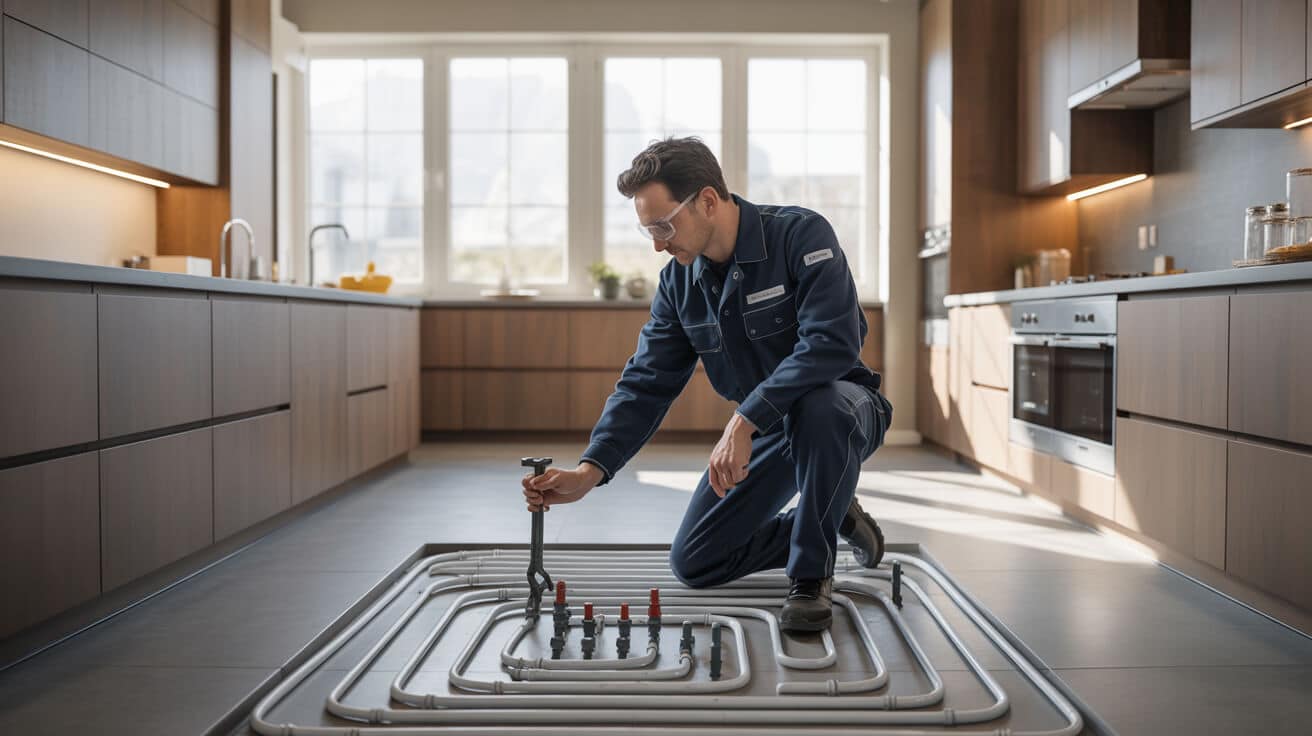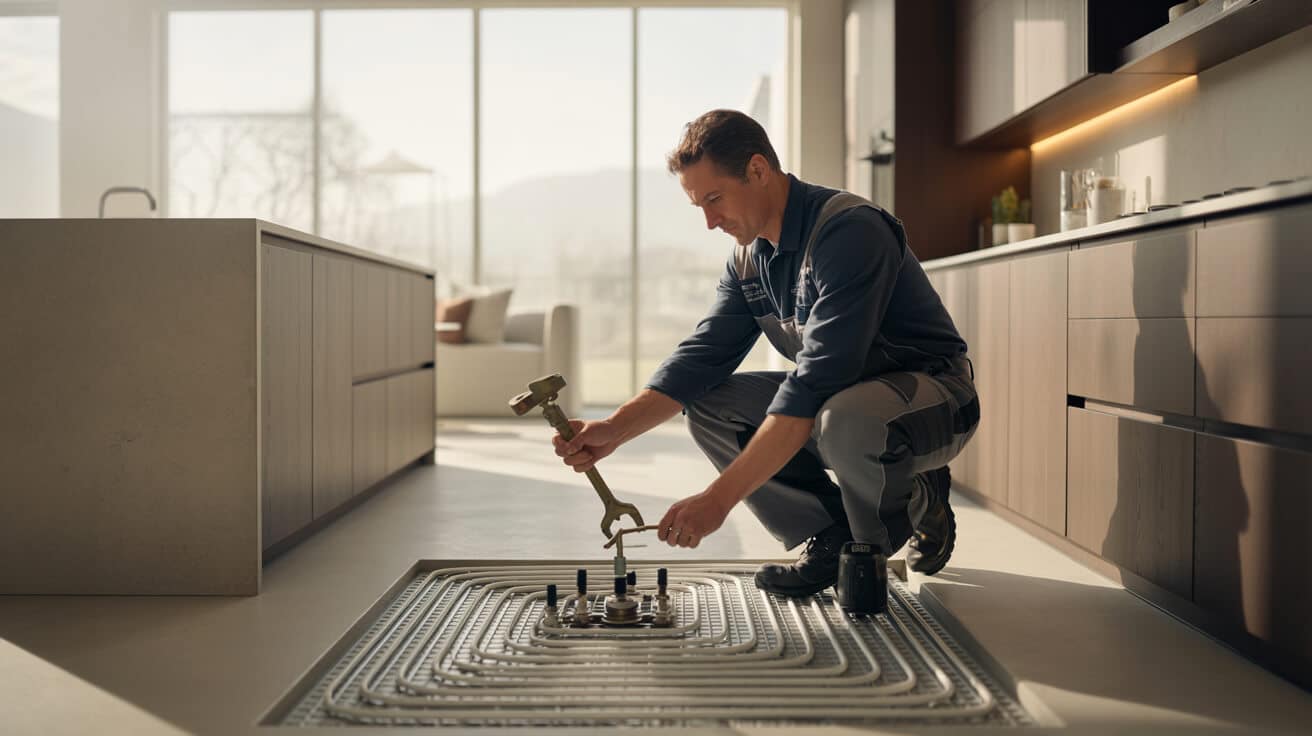Manifold servicing is an integral activity in ensuring stability, energy efficiency, and zonal comfort in properties with hydronic floor heating. Regular attention to this component directly reduces the risk of uneven temperature distribution, system failure, costly emergency repairs, or loss of compliance with national building and water regulations. Guidance from well-trained specialists, including the engineering teams at Plumbers 4U, enables you or your organisation to sustain asset value, achieve energy savings, and secure robust operational documentation for insurance or regulatory review. Contemporary manifold service protocols address the entire ecosystem: from mechanical valves and sensors to digital control and maintenance record integration—resulting in durable, future-ready systems.
Etymology or name origin
The term “manifold” arises from the Middle English “manifald,” itself rooted in Old English and Latin origins denoting “many folds” or “having many forms.” In plumbing and heating contexts, “manifold” has become the standard term for multi-port distribution units, especially those engineered for directing water within complex hydronic networks. As building systems evolved toward greater zoning and precision, the technical definition converged on an assembly capable of simultaneously regulating, isolating, and balancing numerous circuits from a singular hub.
Overview and context
hydronic underfloor heating systems represent a progression from localised emitters to comprehensive, radiant building-wide climate control. The manifold forms the central point of connection for the heat source, typically a boiler or heat pump, and each individual floor circuit. By manipulating flow rates, temperature blends, and operational schedules, the manifold responds dynamically to occupancy patterns, user preference, and external conditions. Market adoption is broad, encompassing high-end domestic residences, commercial premises, hospitality venues, health care institutions, and educational buildings. Within each, manifold servicing underpins system resilience, legal compliance, and property value. Periodic assessment and adjustment mitigate technological obsolescence and prolong infrastructure lifespan.
History
Early radiant heating systems
The roots of hydronic floor heating are found in ancient civilizations. Roman hypocausts and Korean ondol systems paved the conceptual groundwork, channelling heat beneath flooring, albeit without the precision or modularity seen today.
Modular hydronics and the emergence of the manifold
The twentieth century brought industrial materials and advanced plumbing protocols. Closed-loop systems using copper and, later, cross-linked polyethylene (PEX) pipes powered the rise of multi-zone underfloor heating. The need to direct, isolate, and balance flow across these zones led to the introduction of dedicated manifold devices.
Regulatory codification and technological advancement
As hydronic heating became mainstream in the UK and Europe, professional societies and government agencies formalised standards. Bodies such as the Chartered Institute of Plumbing and Heating Engineering (CIPHE), Building Engineering Services Association (BESA), and the Water Regulations Advisory Scheme (WRAS) promoted best practices for safe, reliable, and compliant installations. With regulatory backing, manifold design rapidly adopted features including flow metres, thermostatic actuators, and digital interface compatibility.
Contemporary trends
The twenty-first century has seen manifolds evolve into smart, sensor-rich hubs. Integration with building management systems, predictive controls, remote diagnostics, and mobile documentation are now prevalent. Industry leaders like Plumbers 4U have adopted digital-first methodologies, providing tenanted, commercial, and owner-occupied properties with seamless, value-driven servicing for increasingly sophisticated systems.

Concept and description
Manifold assembly
A typical underfloor heating manifold comprises two horizontal rails, one regulating flow to circuits and the other collecting return flow. Each rail is populated with ports connected to individual pipe loops, usually fabricated from PEX or polybutylene. Between these core elements, manufacturers integrate a variety of design features:
- Balancing valves: Adjust each circuit to achieve hydraulic equilibrium and uniform heat delivery.
- Flow metres: Indicate and calibrate the specific volume of water directed through each loop.
- Thermostatic actuators: Enable granular, automated zone control, triggered by thermostats or building management software.
- Mixing/blending valve: Blends high-temperature supply with cooler return, controlling delivery temperatures to prevent overheating.
- Isolation and bypass valves: Facilitate targeted maintenance or system flushing with minimal disruption to other zones.
- Pressure and temperature gauges: Provide diagnostic data for performance tracking.
- Manual and automatic air vents: Alleviate trapped air, essential for consistent flow and minimising system noise.
System architecture and integration
Manifolds are positioned for accessible servicing—often in a dedicated plant room, service closet, or floor-level cabinet. The assembly ties together:
- The heat source (condensing boiler, air-source or ground-source heat pump)
- circulation pump (drives water through the system)
- Controls (thermostats, timers, BMS connections)
- Thermal sensors (ensure feedback-regulated delivery of comfort)
Functionality, purpose, and typical applications
Climate control through zoning
Zoning is the foundation of hydronic underfloor heating efficiency. By associating each pipe loop with a defined floor area (room or subzone), manifolds allow the sequencing of heating according to real, lived needs. This refinement minimises energy usage while maximising user comfort.
Energy and cost optimization
Efficient manifolds not only support regulatory compliance but contribute to quantifiable reductions in operational costs. Reduced over-delivery, lowered heat loss, and the prevention of cross-zonal leaks or faults contribute to asset longevity—a substantial value point for you as a property owner or manager.
Stakeholder-centric benefits
- For homeowners: Consistency of floor warmth, low maintenance heating, peace of mind.
- For landlords/property managers: Predictable maintenance cycles, tenant satisfaction, compliance security, minimised callouts.
- For facilities teams: Flexibility in scheduling, digital servicing logs, support for large estate management, and insurance documentation.
Example applications
| Property Type | Benefit | Common Integration |
|---|---|---|
| Domestic homes | Even heat, no radiators needed | Manual or semi-automatic |
| Commercial offices | Zoning based on occupancy | Fully automated/smart |
| Managed apartments | Tenant-specific billing, compliance | BMS synced, digital logs |
| Institutional | Scheduled maintenance, energy audit | Remote diagnostics |
Classifications, types, and variants
Domestic and commercial segmentation
- Domestic manifolds: Typically feature simpler, smaller units (4–8 ports), manual balancing, lower flow capacity.
- Commercial/composite: High port count (up to 20+), motorised valves, redundant circuit capacity, advanced sensor arrays.
Manual, semi-automatic, and smart models
- Manual: Balancing and temperature adjustment require technician input.
- Semi-automatic: Integrated thermostatic actuators, pressure-compensating valves, basic feedback.
- Smart/digital: Real-time data collection, remote diagnostics, app-based control.
Specialised variants
- High-corrosion resistant: Stainless steel for aggressive water conditions.
- Ultra-low profile: For renovations or restricted installation depth.
- Combined flow/return compartments: Modular, stackable for custom installations.
Systems, tools, and methodologies
Inspection protocol
Inspection is performed through a methodical sequence:
- Visual inspection for evidence of leaks, corrosion, or poor assembly.
- Verification of flow metres and balancing valves against original commissioning or manufacturer data.
- Inspection of actuators for responsiveness and correct open/close function.
- Testing and, if needed, bleeding of air vents to ensure clear passage.
Servicing and tune-up
Key procedures are rendered both pre-emptively and reactively:
- Cleaning/descaling of flow metres, removal of sludge and limescale.
- Replacement of worn seals, faulty actuators, and defective valves.
- Recalibration of balancing valves for precise, zonal flow rates in response to documented property usage.
- Servicing of mixing valves to set correct supply temperatures, especially after heat source upgrades or system changes.
Tool matrix
| Purpose | Tool/Methodology |
|---|---|
| Balancing | Flow metre, precision wrench, calibration kit |
| Leak detection | Pressure tester, infrared camera, dye test |
| Actuator service | Electrical tester, actuator tool, multimeter |
| Cleaning | Flexible brush, chemical descaler, vacuum |
| Documentation | Digital logbook, cloud maintenance portal |
Documentation and audit
A systematic approach to record-keeping is central. Invoices, photo evidence, service logs, and compliance certificates are maintained and, with companies like Plumbers 4U, often synchronised to digital asset management solutions available to your team or organisation.

Stakeholders and entities involved
End users and owners
The long-term functioning and compliance of manifold systems directly affect property owners, tenants, and buyers. The adoption of digital reporting widens your visibility and control over historical asset maintenance.
Service providers
Professionals, including accredited engineers and technicians from Plumbers 4U, carry out inspection, repair, and systems integration. Specialist training and up-to-date certifications are required due to the layered regulatory context.
Brands and manufacturers
Manufacturers supply a range of design variants, tools, and upgrade kits. High compatibility and thorough documentation by providers enhance both your options and system resilience.
Regulatory and trade bodies
Significant organisations—such as WRAS, BESA, and CIPHE—shape not just the legal standards, but also the cadence of maintenance and service protocols you are required to follow.
Legal, regulatory, and ethical considerations
Statutory frameworks
Multiple laws, standards, and best practices guide manifold servicing:
- Building Regulations Part L: Mandates energy efficiency protocols and system balancing.
- WRAS standards: Specify water materials and control assembly safety and hygiene.
- BS EN 1264: Defines pipework layouts, thermal performance, safety margins.
Documentation and compliance
Mandatory documentation includes commissioning data, service logs, and compliance certificates. Failure to maintain up-to-date, accurate records may void property insurance or new-home warranties.
Service provider registration
Only registered, accredited personnel—such as those validated by WRAS or holding CIPHE membership—may legally sign off major servicing or repairs, ensuring your legal and ethical security.
Performance metrics, data, and measurements
Data-driven assessment
Metrics define both immediate performance and long-range trends:
- Hydronic balance: Based on precise flow readings, recalibrated as conditions evolve.
- Zone temperature uniformity: Surface and air temperature variance, often cross-referenced with infrared analysis.
- Energy usage analysis: Measured before and after servicing to quantify effectiveness.
Service and handover reports
Clear records of procedure, measurement, and remedial works are handed to you or your property manager. Integration with maintenance schedules and asset tracking tools is encouraged, maximising audit readiness.
Challenges, barriers, and limitations
Technical and operational
Difficulties may arise with inaccessible installations (e.g., buried or obstructed manifolds), non-standardised parts, or aged systems incompatible with new hardware. Retrofits may involve disruptive interventions, but strategic planning and phased work by specialists reduce this impact.
Barriers span cost aversion, lack of owner/tenant understanding about system maintenance, and minimal public-facing communication about long-term risks of deferred servicing.
Policy and regulation
Occasional misalignment between fast-evolving energy mandates and the slower pace of regulatory update can create uncertainty for service providers and property owners.
Impact, influence, and legacy
Property value and regulatory normalisation
Routine servicing and robust compliance, especially when performed by market leaders like Plumbers 4U, enhance asset longevity and draught a pathway for the broader uptake of hydronic floor heating as a high-performance, property-enhancing feature.
Sustainability and decarbonization
Optimally serviced manifold systems reduce energy wastage, lower greenhouse emissions, and align properties with net-zero carbon objectives. Well-documented maintenance histories become a valued asset in green property valuation.
Sector modernization
Standardisation of digital documentation, technician upskilling, and alignment with new construction protocols have moved the sector toward high reliability and transparency.
Future directions, cultural relevance, and design discourse
Predictive servicing and digital convergence
The future salience of manifold servicing is set to grow with predictive analytics, sensor-rich components, and the adoption of real-time digital maintenance logs. App-driven reporting and cross-platform asset management will allow your organisation near-instantaneous oversight, encouraging proactive maintenance and peace of mind.
Architectural and design integration
Innovation in concealed and modular manifold designs promises seamless integration with contemporary interiors. As building trends favour open-plan living and minimalist aesthetics, manifolds are likely to further recede from prominence, while remote access and automation become standard.
Policy, training, and cultural adoption
Training curricula are expanding to address the multidisciplinary requirements of system design, installation, and ongoing care. Government and insurer incentives are increasingly tied to demonstrable, documented maintenance. The normalisation of these standards will continue to support cultural acceptance and elevate the perception of hydronic systems, providing you greater security and clarity in both personal and professional property management.

